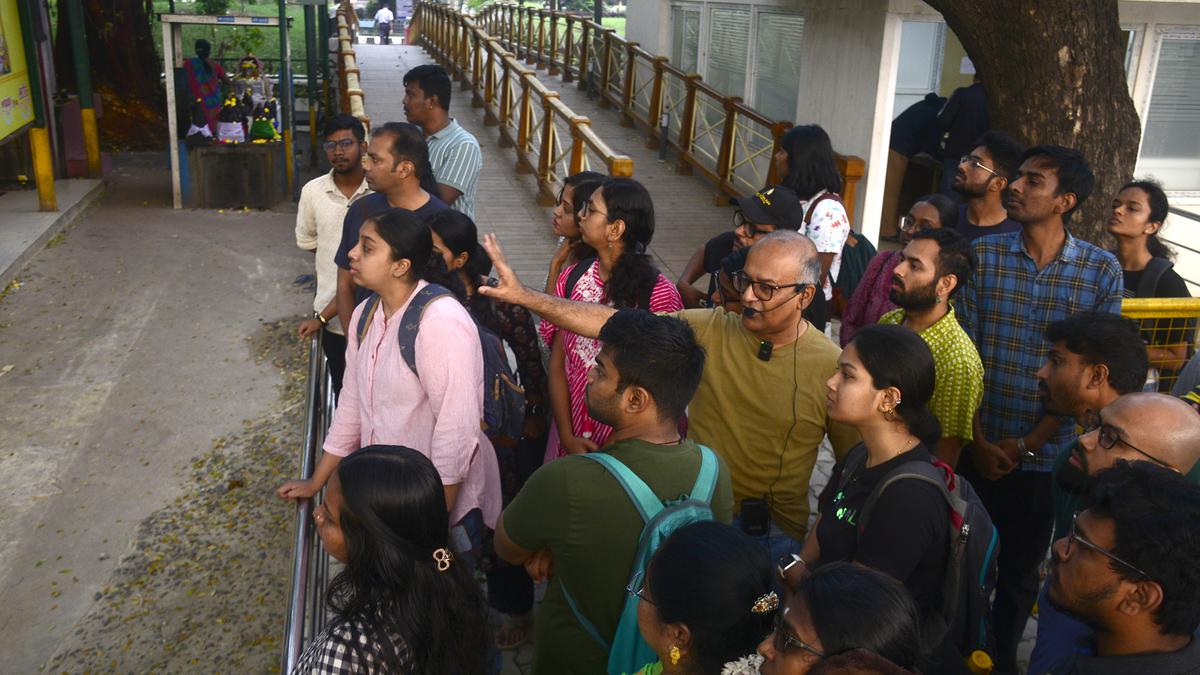
Getting a glimpse of Fort St. George’s rich history through literary works
The Hindu
Explore the historical precinct of Fort St. George in Chennai through a heritage walk led by historian V. Sriram.
As a group of 50 residents cross the polluted moat of Fort St. George for a heritage walk on Saturday, historian V. Sriram pulls out a rare photograph of men fishing in the moat’s clean waters in the 1940s. Pointing to the photo, he says: “This is how the moat used to be in its heyday. There is a case for keeping it clean.”
At the Fort’s car park, Mr. Sriram talks about the sea lapping the walls of Fort St. George three centuries ago, giving anecdotes from H.D. Love’s Vestiges of Old Madras. After being frisked by the police, the group follows Mr. Sriram and a group of volunteers carrying various literary works about the historical precinct with a pervasive mood of nostalgia.
“The Assembly and Secretariat building today, the central portion of it alone, what is behind the entrance portico, that alone was the original Fort House. You can see that the Fort has expanded, it has become a kind of a rectangle with the Fort House in the middle. You are standing exactly at the alignment of the Cooum, the Ezhumbur and the Bay of Bengal. Over a period, streets started coming in, houses came to be built all around the Fort House. Then, you find the Fort slowly eating into the waterbody,” Mr. Sriram says.
“In 1746, when the French came to Madras, they fired a few cannon shots. The British immediately fled to Cuddalore, leaving the Fort to the French. For three years, the French were here, between 1746 and 1749. If they had stayed on, this walk would be in French, not in English. In 1749, they signed what was called the Treaty of Aix-la-Chapelle, and Quebec in Canada was given to the French, and Madras was given to the British. The British came back. Then they started building security around the Fort. Until that time, they had not bothered much with it. In the 1780s, we had Hyder Ali and Tipu Sultan coming. The British were terrified of them. They never stepped out of Fort St. George after sunset,” he says.
While the group nears the Cornwallis Cupola, Mr. Sriram shows them Madras in the Olden Time by J. Tallboys Wheeler. “In the 1780s, we had the Second Anglo-Mysore War and Hyder Ali died. After that, the British felt that Tipu Sultan could never be defeated. They were so frightened of the Tiger of Mysore. Now, at this time you get a Governor-General in Calcutta called Cornwallis. How do we remember Cornwallis? He was defeated in the American War of Independence by George Washington. He comes to India. He comes immediately to the South in 1792 and the Third Anglo-Mysore War breaks out. Tipu Sultan is defeated. Both his sons are taken hostage and brought to Fort St. George,” Mr. Sriram narrates.
As the walkers cross a huge banyan tree, which has grown on top of a dilapidated building maintained by the Archaeological Survey of India, Mr. Sriram explains the heritage building’s link to Arthur Wellesley, who defeated Napoleon. He also speaks of the incidents associated with Robert Clive, his achievements and eccentricities, as the group nears another heritage building, which served as Clive’s residence.
At the side of the Assembly building, Mr. Sriram talks about the book – Life of Thomas Pitt by Cornelius Neale Dalton — and how there were so many allegations of corruption among Colonial Governors, and how Thomas Pitt reportedly made a fortune and his descendants were able to live comfortably, even becoming Prime Ministers. He talks about G.M. Pitt and his association with the Chinna Thari Pettai, where housing based on caste, religion, or community was banned for the first time in India.

The Karnataka government has drafted a comprehensive master plan for the integrated development of Kukke Subrahmanya temple, the State’s highest revenue-generating temple managed by the Hindu Religious Institutions and Charitable Endowments Department. The redevelopment initiative is estimated to cost around ₹254 crore and aims to enhance infrastructure and facilities for devotees.












